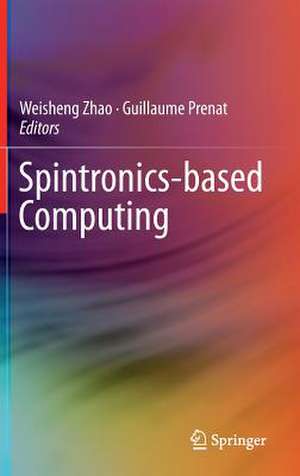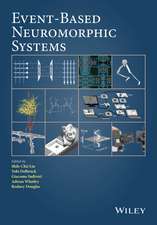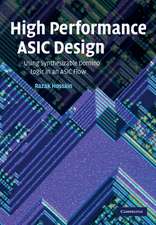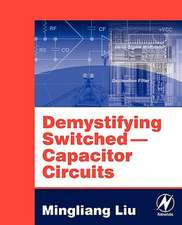Spintronics-based Computing
Editat de Weisheng Zhao, Guillaume Prenaten Limba Engleză Hardback – 22 mai 2015
Preț: 644.95 lei
Preț vechi: 758.77 lei
-15% Nou
Puncte Express: 967
Preț estimativ în valută:
123.41€ • 129.20$ • 102.11£
123.41€ • 129.20$ • 102.11£
Carte tipărită la comandă
Livrare economică 07-21 aprilie
Preluare comenzi: 021 569.72.76
Specificații
ISBN-13: 9783319151793
ISBN-10: 3319151797
Pagini: 250
Ilustrații: IX, 253 p. 199 illus., 174 illus. in color.
Dimensiuni: 155 x 235 x 17 mm
Greutate: 0.54 kg
Ediția:2015
Editura: Springer International Publishing
Colecția Springer
Locul publicării:Cham, Switzerland
ISBN-10: 3319151797
Pagini: 250
Ilustrații: IX, 253 p. 199 illus., 174 illus. in color.
Dimensiuni: 155 x 235 x 17 mm
Greutate: 0.54 kg
Ediția:2015
Editura: Springer International Publishing
Colecția Springer
Locul publicării:Cham, Switzerland
Public țintă
Professional/practitionerCuprins
Introduction.- Spintronics nanodevices for computing.- Characteristics and Compact Modeling of Spintronics nanodevices.- CAD tools for Spintronics nanodevices based circuit simulation.- Interface circuits for Spintronics nanodevice integration.- Logic-in-memory structures with magnetic tunnel junctions.- Spin transfer torque magnetic memory design and simulation.- Reliability design of hybrid logic circuit in the deep submicron technology nodes.- Design methodology and optimization of hybrid Spintronics/CMOS circuits.- Hybrid logic architecture for Nonvolatile VLSI Processor.- Magnetic RAM based Computing Architectures.
Notă biografică
Weisheng Zhao, received the Ph.D. degree in physics from the University of Paris-Sud, France, in 2007. From 2004 to 2008, he investigated Spintronic devices based logic circuits. Since 2009, he joined the CNRS as a tenured research scientist and his interest includes the hybrid integration of nanodevices with CMOS circuit and new non-volatile memory (40 nm technology node and below) like MRAM circuit and architecture design. Weisheng has authored or co-authored more than 120 scientific papers (e.g Advanced Material, Nature Communications, >40 IEEE Transactions etc.); he is also the principal inventor of 4 international patents. Since 2014, he becomes “Youth 1000 plan” distinguished professor in Beihang University, Beijing, China where he leads the Spintronics Interdisciplinary Center. He is a senior member of IEEE.
Guillaume Prenat is a researcher in microelectronics now in charge of the design activity for Spintec Lab. He graduated from Grenoble Institute of Technology in France, in 2002. He obtained a PhD degree in the field of analog and mixed signal testing in 2005. He joined the spintronics laboratory SPINTEC in November 2006 to take in charge the design activity. He holds 6 international patents and has authored or co-authored 45 scientific publications in this field.
Guillaume Prenat is a researcher in microelectronics now in charge of the design activity for Spintec Lab. He graduated from Grenoble Institute of Technology in France, in 2002. He obtained a PhD degree in the field of analog and mixed signal testing in 2005. He joined the spintronics laboratory SPINTEC in November 2006 to take in charge the design activity. He holds 6 international patents and has authored or co-authored 45 scientific publications in this field.
Textul de pe ultima copertă
This book provides a comprehensive introduction to spintronics-based computing for the next generation of ultra-low power/highly reliable logic, which is widely considered a promising candidate to replace conventional, pure CMOS-based logic. It will cover aspects from device to system-level, including magnetic memory cells, device modeling, hybrid circuit structure, design methodology, CAD tools, and technological integration methods. This book is accessible to a variety of readers and little or no background in magnetism and spin electronics are required to understand its content. The multidisciplinary team of expert authors from circuits, devices, computer architecture, CAD and system design reveal to readers the potential of spintronics nanodevices to reduce power consumption, improve reliability and enable new functionality.
Caracteristici
Provides a panoramic view of spintronics nanodevices-based computing Presents material at a level accessible to readers without deep background in magnetism and spin electronics Enables the design of modern electronics, with data non-volatility, hardness to radiation, fast data access and low-power consumption











